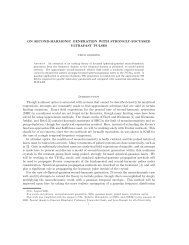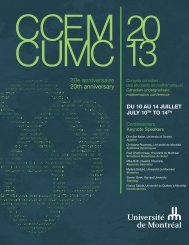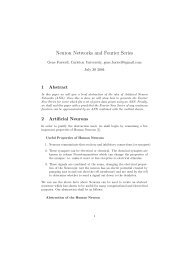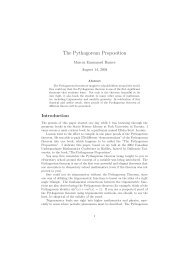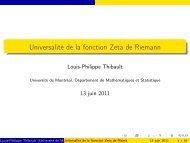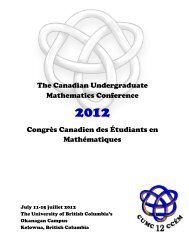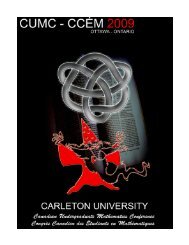booklet - CUMC - Canadian Mathematical Society
booklet - CUMC - Canadian Mathematical Society
booklet - CUMC - Canadian Mathematical Society
You also want an ePaper? Increase the reach of your titles
YUMPU automatically turns print PDFs into web optimized ePapers that Google loves.
INTRODUCTION TO CONGRUENT NUMBERSSARAH DROHANFor an integer n, can we find a right triangle with area n and rational side lengths?While simple to state, this problem is one of the oldest unanswered questions in mathematics.If such a triangle exists, we call the integer n a congruent number. Thus theopen problem of determining whether an integer n is a congruent number is termedthe congruent number problem. This problem was first posed more than a thousandyears ago by the Persian mathematician al-Karaji. Much later Fibonacci and Fermatcontributed by showing respectively that 5 and 7 are congruent numbers and that 1 isnot a congruent number.In this talk, we will discuss the history of this problem and introduce some methodsof finding congruent numbers. Additionally, the relationship of congruent numbers toelliptic curves will be explained. Lastly, I will provide a brief overview of Tunnell’sTheorem and the Birch and Swinnerton-Dyer conjecture.CERTAINTY IN A QUANTUM UNIVERSE: PERFECT STATE TRANSFER IN QUANTUMWALKSSEAN HUNTContinuous quantum walks - quantum analogues to random walks on a graphbased on the matrix U(t) = exp(itA(X)) - form incredibly complex and unintuitivesystems, yet are of great interest to quantum physicists because of their potential toprovide a workable model for the implementation of quantum computers. It was recentlyshown that quantum walks on graphs of maximum degree at most 3 are in factcapable of universal quantum computation. One particular area of interest has beenperfect state transfer: where a quantum walk ends up in a particular state, distinctfrom its starting state, with probability 1.In this talk, I will introduce the notions of the continuous quantum walk and ofperfect state transfer, and demonstrate some known examples and properties of perfectstate transfer on weighted and unweighted graphs.Required Background: Basic knowledge of graph theoryTHE FREDHOLM DETERMINANTSEONG HYUN PARKThis presentation will aim to extend the idea of a determinant from linear maps tooperators on function spaces. The Fredholm determinant defines the determinant onmappings between infinite dimensional spaces, derived from Fredholm’s series expression.I will begin by going over the geometric interpretation of a determinant of a linearmap and its properties. Then, I will define the Fredholm determinant for integral operatorson the function space of all continuous functions defined on the compact interval[0,1], and discuss the notion of eigenfunctions. Finally, I will conclude by giving a briefapplication of the Fredholm determinant towards Brownian motion. Some familiaritywith function spaces and matrices are required.Required Background: Real Analysis, Linear Algebra45



